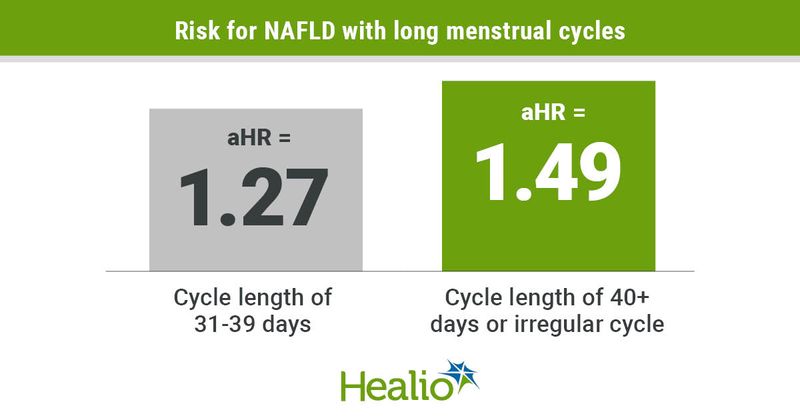Long, irregular menstrual cycles may increase NAFLD risk for premenopausal women
Premenopausal women with long or irregular menstrual cycles have a higher risk for prevalent and incident nonalcoholic fatty liver disease compared with women with normal cycles, according to study findings.

“Long or irregular menstrual cycles were associated with higher prevalence of and also increased risk of developing nonalcoholic fatty liver disease in young, premenopausal women, and this association was not explained by obesity,” Seungho Ryu, MD, PhD, professor at the Center for Cohort Studies, Total Healthcare Center, Kangbuk Samsung Hospital, Sungkyunkwan University School of Medicine, and SAIHST, Sungkyunkwan University in Seoul, South Korea, told Healio. “Young, premenopausal women with long or irregular menstrual cycles should be aware of future risk of developing nonalcoholic fatty liver disease and advised to engage in healthy lifestyle behaviors such as regular physical activity and healthy dietary habits to reduce risk of developing nonalcoholic fatty liver disease and other metabolic diseases.”

Ryu and colleagues analyzed data from the Kangbuk Samsung Health Study of 135,090 premenopausal women younger than 40 years who underwent an annual or biennial health exam at health care centers in Seoul or Suwon, South Korea. Participants took part in a comprehensive health examination from 2011 to 2017 and had at least one follow-up exam conducted by Dec. 31, 2019. Menstrual cycle length was self-reported, and cycle lengths were categorized as less than 21 days, 21 to 25 days, 26 to 30 days, 31 to 39 days and 40 days or more or too irregular to estimate. Women were diagnosed with nonalcoholic fatty liver disease (NAFLD) based on hepatic steatosis observed in an abdominal ultrasound.
At baseline, 7.1% of the cohort had prevalent NAFLD and 27.7% had an irregular menstrual cycle or a cycle length of 40 days or more. After adjusting for covariates, women with a menstrual cycle length of 31 to 39 days (adjusted prevalence ratio [aPR] = 1.27; 95% CI, 1.19-1.36) or 40 days or more (aPR = 1.35; 95% CI, 1.28-1.42) had a higher risk for NAFLD compared with women with a 26- to 30-day menstrual cycle length.
In the subgroup of women without NAFLD at baseline, 4,524 cases of NAFLD were diagnosed during a mean follow-up of 4.4 years. Compared with women with a menstrual cycle length of 26 to 30 days, those with a cycle length of 31 to 39 days (aHR = 1.27; 95% CI, 1.15-1.39) or those with a cycle length of 40-plus days or an irregular cycle (aHR = 1.49; 95% CI, 1.38-1.6) had an increased risk for being diagnosed with NAFLD. In sensitivity analysis, having a menstrual cycle length of at least 40 days or an irregular cycle was also associated with a higher risk for moderate or severe NAFLD.
In an analysis of 18,968 women with data with pelvic ultrasounds and gynecologic assessments available, those with a 31- to 39-day menstrual cycle (aPR = 1.28; 95% CI, 1.11-1.46) and a 40-plus day or irregular cycle (aPR = 1.42; 95% CI, 1.27-1.58) had an increased likelihood for NAFLD. In 14,378 women with NAFLD or suspected polycystic ovary syndrome at baseline, there was also an increased risk for NAFLD in those with a 31- to 39-day menstrual cycle (aHR = 1.23; 95% CI, 1.03-1.47) or a 40 day-plus or irregular cycle (aHR = 1.32; 95% CI, 1.15-1.52).
“The association between long or irregular cycles and risk of developing NAFLD was independent of obesity and consistently observed in women without polycystic ovary syndrome, which means that women with long or irregular menstrual cycles should be encouraged to engage in healthy lifestyle behaviors regardless of obesity status or PCOS,” Ryu said.
Ryu said future research should include hormone measurements that may explain the associations between long and irregular menstrual cycles and NAFLD. Future research is also needed to determine whether implementing healthy lifestyle behaviors in women with long or irregular cycles may reduce NAFLD risk.
For more information:
Seungho Ryu, MD, PhD, can be reached at sh703.yoo@gmail.com.
